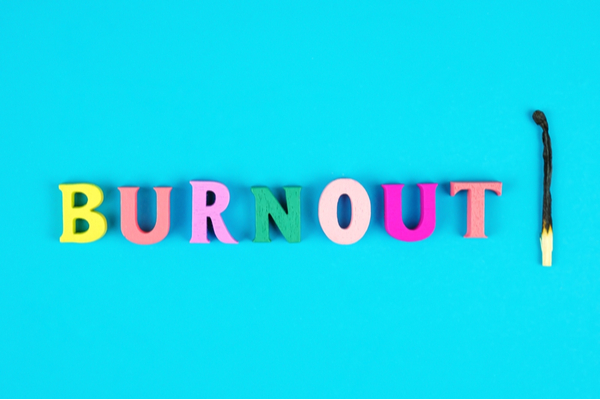Burnout is sadly common in modern society, and chances are if you haven’t experienced burnout yourself, you probably know someone who has. Often known as chronic workplace stress, it can affect people in any workforce at any level, from a grocery store junior cashier to a chief executive of a global corporation.
Early childhood educators are not immune to burnout — in fact, it’s unfortunately a highly reported issue in the sector. This needs to be addressed, and by having a better understanding of what burnout looks like, we can be equipped to know how we can support those experiencing it.
Better yet, an insight into burnout in the workplace can help us to prevent it happening in the first place.

Understanding burnout and what causes it
Burnout is a state of being that involves feeling depleted. It’s generally acknowledged to be a work-related stress, though other factors could contribute and trigger burnout for a person.
While it’s not new, burnout is being increasingly reported, especially in the wake of going on two years of life overshadowed by a global pandemic. Heading in and out of lockdowns, we are one moment conditioned to being in a strange living situation where we only do and see the bare minimum, while the next moment we are launched back into life as we once knew it. This can take its toll.
On top of this, those working in early childhood education have had to adapt to new early childhood education circumstances that have added a new level of pressure in the workplace. Stringent cleaning protocols, understanding virus spread and prevention strategies, evolving policies around interacting and mask-wearing, taking temperature checks and more have all piled on to the responsibilities of being an essential worker in early childhood education.
Identifying symptoms of burnout in ECEC
It’s worth noting that while anyone can experience burnout, it doesn’t look the same for each person.
Here are a few of the key symptoms of burnout that you should be aware of to better identify them in yourself or in those around you:
- Feeling exhausted: Exhaustion from burnout is often psychologically based, but can feel like a physical, emotional or mental exhaustion.
- Less able to connect emotionally: Educators experiencing burnout could feel disconnected from co-workers and even children.
- Sense of meaninglessness: People suffering burnout tend to lose sight of the point of doing anything. They might feel like they are not making a difference.
- Loss of motivation: A once-motivated educator might begin to lack that drive and no longer experience satisfaction from things they previously enjoyed.
Needless to say, these symptoms of burnout can have a negative impact on individuals working in early childhood education. In addition, they can affect the workplace more broadly as well as children’s early childhood education experience.
Alleviating and preventing burnout in early childhood education
If you notice symptoms of burnout in yourself or in others, there are many things you can do to navigate and manage burnout. Further, embedding these strategies into general day-to-day life could prevent burnout from occurring in the first place. After all, prevention is the best medicine.
Here are few strategies that are great to conquer that heightened stress that you can put in place for managing burnout in the workplace:
Bring movement into each day
Movement in any form can reduce stress by releasing endorphins while also reducing the hormones that cause stress in the first place. Don’t think of it as exercise necessarily — find a movement that you enjoy. It could be dancing, cycling, yoga and more.
Spend time outdoors
Research suggests that just minutes into being outdoors we are less stressed or tense. Make an effort to take activities, exercise or even just mindful moments outside and get close to nature whenever possible.
Utilise mindfulness
Mindfulness is the act of being present in the moment. By doing this we are less likely to be distressed by over-thinking around the past or future.
Take time
While there are schedules to keep to, try to minimise rush times throughout the day. Calm transitions with plenty of time to achieve what you need to are ideal. It’s also important to ask to take time off from work if needed so you can restore and return feeling better.
Most of these tactics can even be incorporated into your day at work in an early childhood education setting. Children can enjoy them too and enjoy many benefits for themselves!
Supporting wellbeing in early childhood education teams
An educator’s wellbeing can have a direct impact on their ability to do their job to the best of their ability. And as the saying goes, you cannot pour from an empty cup. With this in mind, to ensure educators have the capacity to be caring, patient and enthusiastic in the workplace, it is vital that early childhood education services put effort into supporting wellbeing.
Employers and senior management in early childhood education settings can support staff in many ways, including:
Leading with kindness
While work is important, each individual’s wellbeing should always come first. We often don’t know what another person is experiencing in their lives, and a little kindness can go a long way. Showing compassion and empathy to your employees, especially if they seem to be going through a hard time will ensure they feel supported.
Providing recognition
Ensuring your employees feel valued and appreciated can contribute greatly to their wellbeing. Take note of educators’ accomplishments both individually and as a team and make it known! It doesn’t have to be a grand gesture, but a note in the staff room, a conversation or a box of chocolates can say a lot.
Keeping up communication
An open line of communication means you are more likely to be able to keep on top of how educators in the workplace are feeling. Make the effort to check-in individually with your team, whether it’s a phone call, email or a note.
Offering support
You don’t need to wait for employees to ask for help or support — if you identify a staff member who seems like they might need something, reach out. It could be as simple as offering a change of shift or asking if they need to talk about anything.
We are all in this together, and no-one is immune to burnout. By putting the human beings in the workplace (including ourselves!) at the top of the priority list, we place everyone in the early childhood education sector in the best position for success in the short and long-term.
That means we can all continue to work towards giving children a strong foundation for a bright future.




